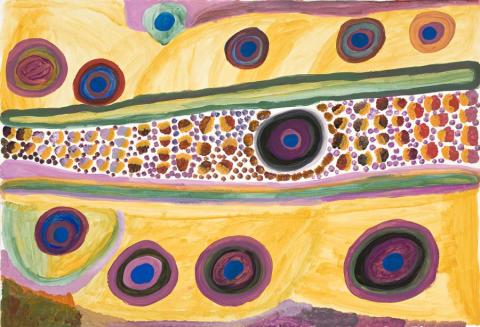JIRTIRR, 1991
Jukuja Dolly Snell
synthetic polymer paint on Arches paper
77.0 x 112.0 cm
inscribed verso: artist's name, Mangkaja Arts cat. WP666/92
Mangkaja Arts, Fitzroy Crossing
Hogarth Galleries, Sydney
Private collection, New South Wales
Ryan, J., (ed), Images of Power, Aboriginal Art of the Kimberley, National Gallery of Victoria, Melbourne, 1993, p. 67 (illus.)
Curator Judith Ryan, in her influential publication Images of Power, Aboriginal Art of the Kimberley, which accompanied an exhibition of the same name, noted that this work ‘shows a sacred place near Fishers Bluff, a hundred kilometres west of Yagga Yagga. “This is a good place to come to. Good water.” A tree with gnarls in its trunk is spread–eagled across the surface, with roots, knots and branches schematically represented. Lightning caused the tree to fall into the waterhole where it is living now. The gray arcs indicate dark rain clouds, the yellow semicircles pamarr (rocks) and the green strip indicates yulka (grass). Clouds appear at the top and grass below. The small circles are jalurn (hail stones) and the large blue circle is the important waterhole. Jukuja has used colour ironically and symbolically to designate elements of the narrative. She has mixed grey for the clouds, brown for the tree and green for the foliage. The rocks, however, are bright yellow and the water is an idyllic deep blue.'1
1. Ryan, J., (ed), Images of Power, Aboriginal Art of the Kimberley, National Gallery of Victoria, Melbourne, 1993, p. 67
